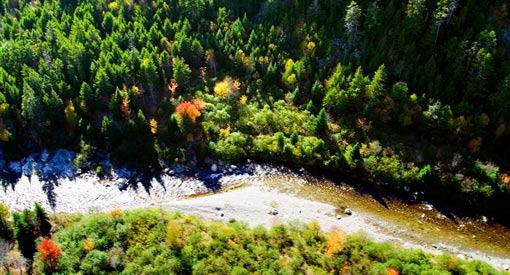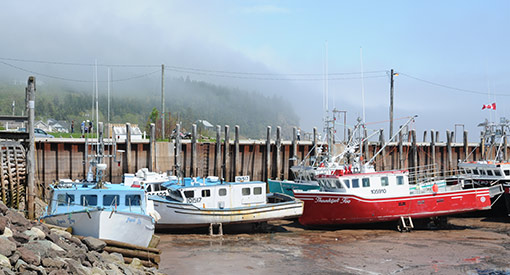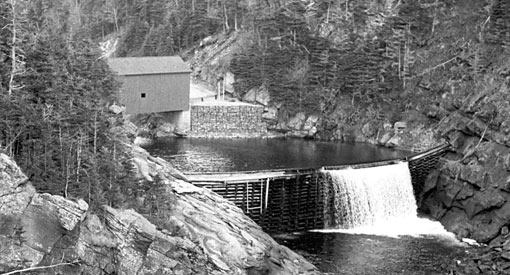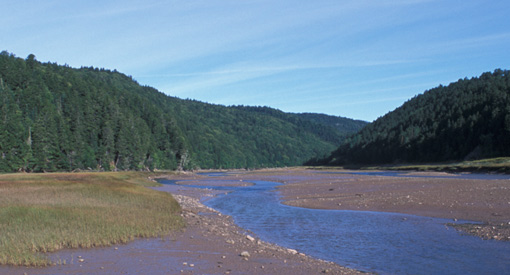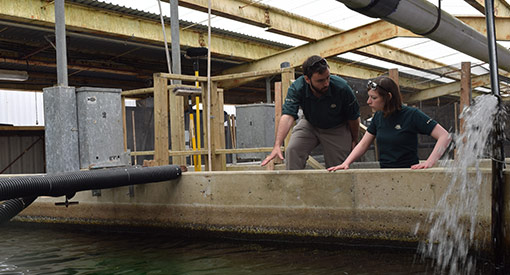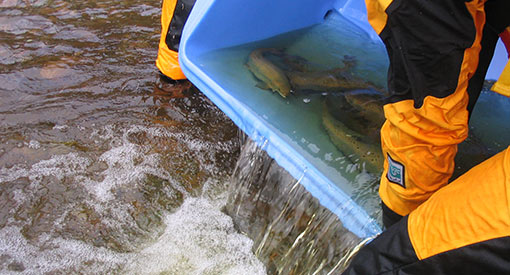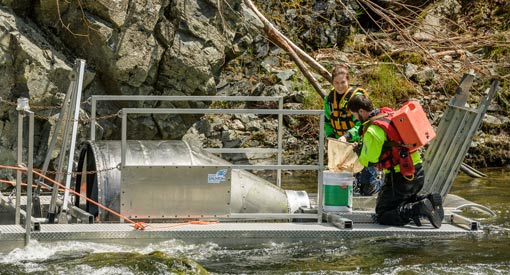
Recovering Inner Bay of Fundy Atlantic Salmon
Fundy National Park
From river to ocean
The life cycle of Inner Bay of Fundy Atlantic Salmon.
Swimming with the tides
Atlantic Salmon adapt to thrive in the Bay of Fundy.
Damaged connections
Years of human activity has created issues in the ecosystem that impacted Inner Bay of Fundy Atlantic Salmon.
Empty rivers
At one point the entire population of Inner Bay of Fundy Atlantic Salmon was facing extinction.
Action in the face of extinction
At one point the entire population of Inner Bay of Fundy Atlantic Salmon was facing extinction.
Reasons for hope
Our work with partners to bring back the salmon population.
Inner Bay of Fundy Atlantic salmon have lived for thousands of years in the Bay of Fundy, connecting forests to the ocean. However, wild salmon have disappeared from the region, leaving the population at risk of extinction.
Connecting People, Rivers, and the Bay
Now, Parks Canada is working with its partners to bring the King of Fish back to Fundy Rivers.
Useful links
Fundy Salmon Recovery
Transcript
Animated title sequence: Parks Canada logo, Fundy Salmon Recovery logo.
[Montage of various views of the Bay of Fundy.]
Narrator: On Canada’s Atlantic coast, between New Brunswick and Nova Scotia, is the Bay of Fundy. Here, among the highest tides in the world, we find the last remnants of the Inner Bay of Fundy Atlantic Salmon. It’s one of the most endangered species in eastern North America, but Fundy National Park and its partners are trying to bring it back - and they may be close to a breakthrough.
[An Atlantic Salmon being shown to camera.]
In the Bay of Fundy, the salmon is an iconic symbol of a healthy environment. It acts as a bridge between the forest and ocean.
Animation: The salmon's place in the ecosystem.
After spending their early years living in freshwater streams, salmon travel to the nutrient-rich waters of the ocean to grow into adults. Once mature, they return to their natal rivers to spawn, starting the cycle again and bringing with them nutrients that help river ecosystems thrive. Most Atlantic Salmon head to the Labrador Sea to feed, where they spend up to three years before returning to spawn. But the incredible Fundy tides carry so many nutrients, that salmon here never have to leave the bay to find the food they need, and mature in just one year. After practicing this shortened migration for thousands of years, the Inner Bay of Fundy salmon have become genetically distinct from other Atlantic salmon. The fact that these fish are special has long been known to people here, who call the salmon the “King of Fish.” For centuries, the yearly return of 40,000 salmon to the bay’s rivers was an important part of the local culture and economy. Sadly, today, fewer than 200 salmon return to spawn annually. So why is this once abundant fish now facing imminent extinction? The short answer is that no one knows. Scientists suspect that something is happening in the ocean environment. When the Inner Bay of Fundy Salmon was listed as endangered in 2001, people here knew they had to take action. Fundy National Park collected some of the last young salmon from park rivers and put them into a hatchery to preserve the unique genetic makeup of the fish. Today the ‘live gene bank,’ at the Mactaquac Biodiversity Facility, is the fish’s final defense against extinction, and the foundation of the Fundy Salmon Recovery program. Under the stewardship of the Department of Fisheries and Oceans, fish are grown here from the original genetic stock, and released back into the rivers.
[People releasing fish into a river with trucks and large nets.]
While the gene bank has kept the Inner Bay of Fundy Salmon alive, after releasing fish for more than a decade - there’s been no marked increase in adults returning to the rivers to spawn. But along the way researchers discovered something interesting: the more wild exposure the fish had, the better their chances of survival, and fish that hatched in the wild were the most robust. The problem was, that a lot of spawning-aged adults would be needed to get the population back on track.
Animation: New Fundy Salmon recovery method.
Here’s what being tried now: Young salmon from the gene bank are being released into rivers, and given time to grow in the wild. But instead of letting all the juveniles head out into the ocean - where chances of survival are slim - some fish are captured and transported to the world’s first Wild Salmon Marine Conservation Farm on Grand Manan Island in the Bay of Fundy. Here at a little place called Dark Harbour, Fundy National Park has partnered with the Province of New Brunswick, Atlantic Canada Fish Famers Association and Cook Aquaculture, who have the know-how to grow large numbers of salmon in sea cages. Getting the fish from the rivers to the farm is the responsibility of the Fort Folly First Nation’s highly skilled habitat recovery team.
[Dark Harbour sea cages]
Once at the farm, the salmon benefit from exposure to the ocean, and are kept safe until spawning age. In coming years, thousands of adult fish will be moved from the Wild Salmon Marine Conservation Farm back to their spawning grounds in Fundy rivers.
[Montage of helicopters lifting fish totes into the air, and people releasing the salmon back into Fundy rivers.]
The hope is that they’ll produce enough offspring to jump-start the wild population. The Fundy Salmon Recovery team can even monitor the fish after their release, thanks to trackers inserted by University of New Brunswick scientists. The tide may be turning for the Inner Bay of Fundy Atlantic Salmon. Early results indicate the survival rate of offspring from these adults is much higher than with past recovery methods. For local communities, the anticipation of the salmon’s return is growing. Hundreds of people attend salmon releases, and participate in Fundy National Park’s ‘Swim with Salmon’ program. The Fundy Salmon Recovery program now serves as a model for others working to recover wild salmon populations - once again connecting the ocean to the forest, and Canadians with Nature. To learn more and to get involved, visit: pc.gc.ca/fundy
Partner logos.
Parks Canada logo.
© Her Majesty the Queen in Right of Canada, represented by Parks Canada, 2017.
Canada wordmark.
Exploring the Fundy Salmon Reintroduction Program
Transcript
Parks Canada logo animation
[Catherine McKenna and Corey Clarke by a river in Fundy National Park]
[Catherine McKenna] Corey, you are an Ecologist with Funday National Park So tell me about the salmon recovery initiative
[Covery Clarke] The Funday salmon recovery initiave is more of a formalisation recently of a long term Atlantic Salmon recovery program that's been underway here in the inner Bay of Fundy and particularly focused in Fundy National ParkA lot of groups have been working for a long time because unfortunately across Atlantic Salmon's range, you know, there's some bad situations out there as far as declining populations. That's no different here in Fundy National Park, here in the inner Bay of Fundy, one of the most endangered salmon populations in the world we've been working at it for over a decade and recently we've seen some things that give us some hope and that is by growing our partner group to include the aquaculture industry we're allowed to release large numbers of wild-origin adult salmon into the river and our partners are seeing really notable gains in wild fitness which could ultimately lead to a recovery of the population on a sustainable basis. [Catherine McKenna] So that's really exciting! We're going to hopefully see more salmon right here especially you said in September?
[Corey Clarke] You bet!
Parks Canada signature
© Her Majesty the Queen in Right of Canada, Represented by Parks Canada, 2017.
Canada wordmark
- Date modified :
